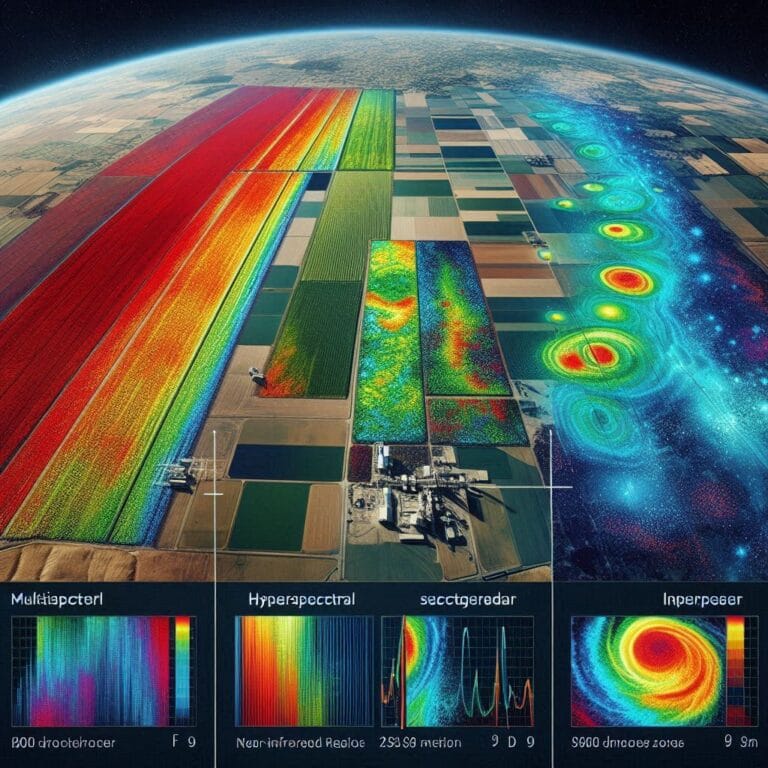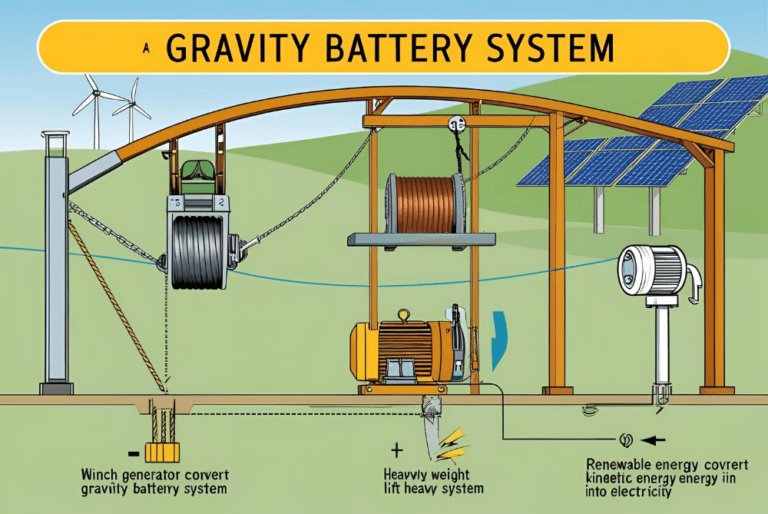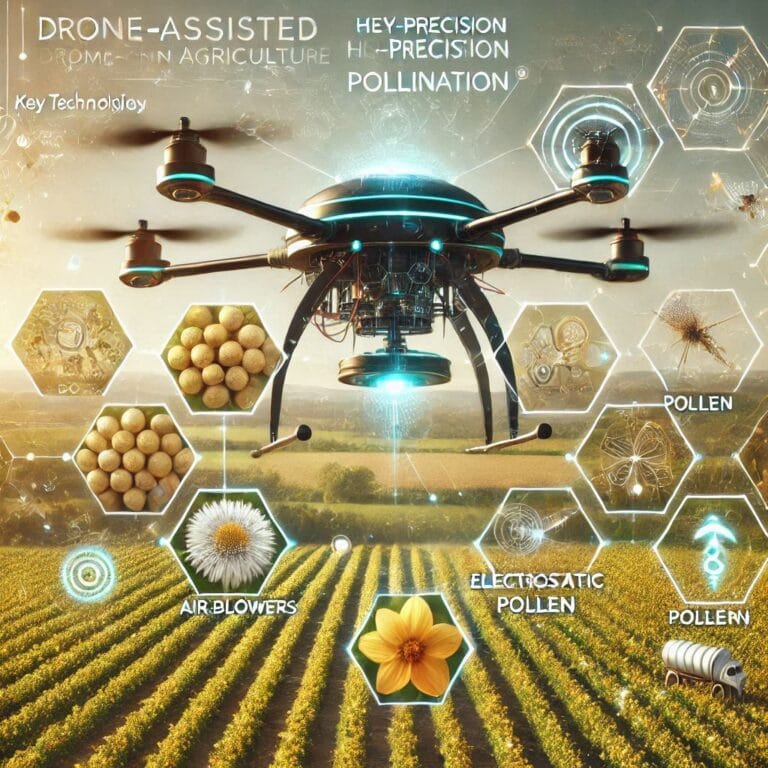Introduction- Invention of the Electricity:
The invention of the electricity, the invisible hand shaping our modern world, isn’t quite an invention nor a singular discovery. It’s a tapestry woven from countless threads, a saga of human curiosity, experimentation, and a growing understanding of the universe’s fundamental forces. Unlike a light bulb, meticulously designed and brought to life in a lab, electricity existed long before we grasped its potential. Ancient Egyptians felt the numbing shock of electric catfish, Greeks marveled at amber attracting light objects, and lightning’s crackle inspired awe and fear across civilizations. These were fleeting encounters, glimpses of a hidden power waiting to be unraveled.
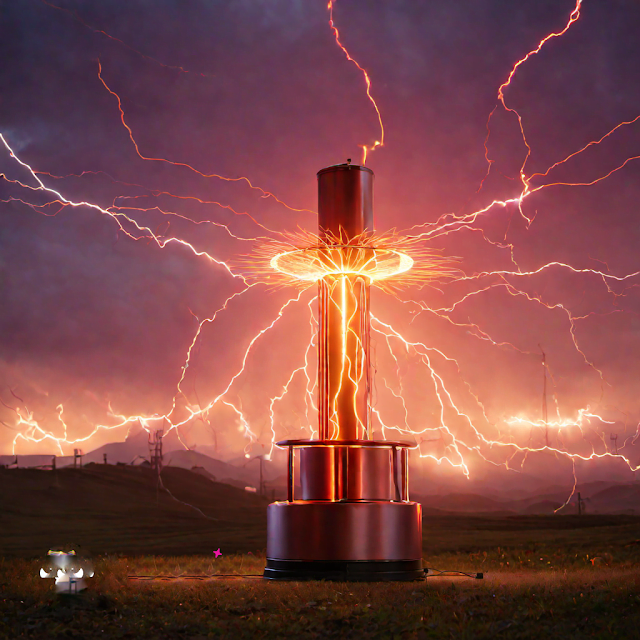
Our journey towards harnessing electrical energy wasn’t a linear march of progress. It was a series of discoveries, building upon each other like Lego bricks. Think of Benjamin Franklin’s daring kite experiment in 1752, not as inventing electricity, but as unlocking its true nature – a powerful current coursing through the clouds, waiting to be channeled. Then came Luigi Galvani’s bio-shock in 1791, observing a frog’s leg twitch near an electrical spark, igniting the field of bioelectricity and revealing the intricate dance of electricity in living beings. Each milestone, from Alessandro Volta’s first battery in 1800 to Michael Faraday’s groundbreaking work on electromagnetism in the 1820s, added another piece to the puzzle.
So, while we didn’t invent electricity in the traditional sense, we gradually “discovered” its secrets, learned to control its flow, and harnessed its immense potential. This ongoing exploration continues today, with scientists delving into quantum mechanics, exploring renewable energy sources, and pushing the boundaries of miniaturization in electronics. The story of electricity isn’t just about the past; it’s a thrilling chapter in humanity’s ever-evolving relationship with the universe, a testament to our insatiable curiosity and ingenuity in transforming mere sparks into the engine of our modern world.
What is Electricity?
Electricity is a fundamental physical phenomenon associated with the flow of electric charge, predominantly carried by electrons in most conductive materials. At the atomic level, electrons are negatively charged subatomic particles that orbit the nucleus of an atom. When an external force, such as a voltage difference or electromotive force, is applied across a conductive medium like a metal wire or a circuit, it exerts a force on the free electrons, causing them to move in a specific direction.
In conductive materials, such as copper or aluminum, the outer electrons of the atoms are loosely bound, allowing them to break free from one atom and move to neighboring atoms when an electric potential difference exists. This movement of electrons results in the establishment of an electric current, which can be visualized as the net flow of negative charge from one point to another within a closed circuit.
The flow of electricity obeys Ohm’s law, which states that the current (I) flowing through a conductor is directly proportional to the voltage (V) applied across it and inversely proportional to its resistance (R), represented by the equation: I = V / R. This relationship helps to control and regulate the flow of electricity in various electrical components and devices.
Electricity is harnessed and distributed through power generation stations, transmission lines, and distribution networks.
Discovery and Early Observations:
The concept of electricity dates back to ancient times when early civilizations observed static electricity through phenomena like lightning and electric shocks from certain objects. However, it wasn’t until the 17th and 18th centuries that significant progress was made in understanding and harnessing this mysterious force.
Ancient Encounters: The Seeds of Electricity Sown (2750 BCE – 600 BCE)
Electricity, the lifeblood of our modern world, boasts a history far older than the first light bulb. While its widespread use emerged much later, the seeds of its understanding were sown in the fertile ground of ancient civilizations, where curiosity and observation ignited the first sparks of discovery.
Egyptians and the “Thunderer of the Nile”:
Imhotep (2600 BCE):
- This enigmatic figure, architect, physician, and polymath, may have laid the earliest foundation. While evidence remains debated, some scholars suggest his writings and designs allude to devices resembling Leyden jars, capacitors used to store static electricity. Did he stumble upon this phenomenon through experimentation, or was it mere coincidence?

Electric Fish:
- The Nile River teemed with “Thunderer of the Nile,” a powerful electric catfish capable of delivering jolts. Ancient Egyptians documented these encounters, likely attributing the shocks to supernatural forces. However, these observations passed down through generations, laid the groundwork for future understanding of bioelectricity.

Greeks and the Lure of Amber:
Thales of Miletus (624-546 BCE):
- Rubbing amber with fur, Thales observed its ability to attract objects like feathers and straw. While his explanation, attributing it to “soul-like” qualities, was inaccurate, it sparked the first recorded investigation of static electricity. This seemingly simple act ignited a centuries-long journey of exploration.
Empedocles (490-430 BCE):
- This philosopher proposed four fundamental elements – earth, water, air, and fire. While not directly related to electricity, some interpretations suggest his concept of “aether,” a fifth element filling the void between celestial bodies, might have hinted at an early understanding of unseen forces, potentially including electrical ones.
These ancient encounters, though seemingly isolated, were crucial stepping stones. They laid the foundation for future discoveries, paving the way for the giants of electricity yet to come. Remember, history is rarely a linear progression; it’s a tapestry woven with threads of curiosity, observation, and the gradual accumulation of knowledge. The ancient world planted the seeds of electrical understanding, waiting to be nurtured by the hands of future generations.
Further Exploration:
- Edwin C. Krumacher, “The Gods of Ancient Egypt” (2001): Provides insights into Egyptian beliefs and practices, including possible interpretations of Imhotep’s work.
- Carl Sagan, “Cosmos” (1980): Explores the history of science and technology, including the early understanding of electricity.
- Benjamin Farrington, “Greek Science” (1949): Offers a comprehensive overview of scientific thought in ancient Greece, including the contributions of Thales and Empedocles.
Medieval and Renaissance (1200 – 1750):
Peter of Maricourt (13th century):
This French scholar, often referred to as Peter Peregrinus, stands out for his visionary treatise, “Epistola de Magnete.” In this work, he not only differentiated magnetism from static electricity but also, remarkably, proposed a perpetual motion machine potentially powered by static electricity. Though his machine remained theoretical, it showcased the early human desire to harness this unseen force for practical applications.
Giambattista della Porta (1535-1615):
This Italian polymath, known for his diverse interests, made significant contributions to the understanding of static electricity. His book “Natural Magic” documented numerous experiments with charged objects, including their attraction and repulsion. He observed the phenomenon of electrification through friction, unknowingly paving the way for later discoveries about conductors and insulators.

Further Studies and Historical References:
- In various historical editions and translations, Peter of Maricourt’s “Epistola de Magnete” can be found.
- Giambattista della Porta’s “Natural Magic” has been translated and reprinted several times, making it accessible to modern audiences.
- Several historical studies explore the development of early electrical knowledge, such as:
- “The History of Electricity” by Isaac Asimov
- “Sparks of Genius: The History of Electricity” by John Malone
- “A History of Electricity” by Charles Williams
William Gilbert (1544-1603): The Magnetizer and Wordsmith:
This English physician and scientist delved deep into the mysteries of magnetism and electricity. His landmark work, “De Magnete,” published in 1600, differentiated the two forces for the first time, paving the way for further exploration. Not only did he coin the term “electricus,” but also conducted meticulous experiments with amber, noting its ability to attract light objects after rubbing. Despite limitations in technology, Gilbert’s meticulous observations laid the groundwork for future advancements.
Otto von Guericke (1602-1686): Sparking Curiosity with the Electrostatic Generator:
This German polymath, fueled by his fascination with natural phenomena, invented the first electrostatic generator in the mid-17th century. His ingenious device, employing a rotating sulfur globe and wool cloth, generated static electricity, reigniting scientific interest in the field. Guericke’s demonstrations, including producing sparks and illuminating a globe with the generated electricity, captured the imagination of scientists across Europe.

Robert Boyle (1627-1691): Repelling the Unknown, One Spark at a Time:
This Irish natural philosopher, renowned for his contributions to chemistry, also dabbled in the realm of electricity. Through meticulous experiments with charged objects, Boyle established the principle of repulsion between like charges. His groundbreaking work not only challenged existing theories but also provided crucial insights into the fundamental nature of electrical forces.
Stephen Gray (1666-1736): Conducting a Revolution, One Material at a Time:
This English astronomer and experimenter made a pivotal discovery in 1729 – the distinction between conductors and insulators. Using hemp thread, he transmitted static electricity over significant distances, demonstrating that certain materials facilitated the flow of electricity while others resisted it. This crucial finding unlocked the potential of electricity to travel beyond immediate contact, paving the way for future innovations.
C.F. du Fay (1698-1739): Unveiling the Duality of Electricity:
This French scientist built upon the work of his predecessors by identifying two distinct types of electricity in 1733. He termed them “vitreous” (generated by rubbing glass) and “resinous” (generated by rubbing resin), later renamed positive and negative respectively. This discovery revolutionized our understanding of electrical forces, laying the foundation for future advancements in batteries, circuits, and beyond.
The “Renaissance Reemergence” of electricity showcases the power of collective inquiry. Each individual, through their unique contributions, illuminated a different facet of this enigmatic force. From Gilbert’s differentiation to Guericke’s generator, Boyle’s repulsion principle to Gray’s conductors and insulators, and finally du Fay’s duality, these pioneers unraveled the secrets of electricity, paving the way for the electrifying world we live in today.
Further Exploration:
- For a deeper dive into the life and work of each individual, explore their biographies and primary sources like “De Magnete” by Gilbert.
- Learn about the social and intellectual context of the Renaissance Reemergence, understanding how these factors influenced scientific inquiry.
Franklin’s Spark (1752):
Benjamin Franklin’s kite experiment:
While Benjamin Franklin’s 1752 kite experiment remains the iconic image, his journey with electricity was far more nuanced and multifaceted. Inspired by earlier studies like Pieter van Musschenbroek’s Leyden jar and Ewald Georg von Kleist’s experiments, Franklin wasn’t just seeking to prove lightning’s electrical nature. He aimed to understand its behavior, harness its power, and protect lives from its destructive force.
The Daring Experiment:
On a stormy day in June 1752, Franklin, accompanied by his son William, ventured out with a silk kite attached to a hemp string and a key tied to the end. As the kite soared, the rain-soaked hemp conducted the electrical charge, causing a spark when Franklin touched the key. This wasn’t just a one-time event; he repeated the experiment, collecting sparks in Leyden jars and observing their effects.
Unveiling the Secrets: Through these experiments, Franklin:
- Confirmed lightning as a powerful electrical discharge. This challenged prevailing theories of lightning as fiery explosions or divine retribution.
- Discovered the existence of positive and negative charges. He observed the attraction of unlike charges (spark) and repulsion of like charges (diverging fibers of the kite string).
- Invented the lightning rod. Inspired by his findings, Franklin designed the lightning rod, a grounded conductor that safely redirects lightning strikes away from buildings, saving countless lives.
Beyond Franklin: A Symphony of Sparks:
While Franklin’s contributions are undeniable, the story of electricity’s “discovery” is far richer. Here are some lesser-known figures who added their own sparks to the flame:
- Mary Fairfax Somerville (1780-1872): Despite societal limitations, this Scottish mathematician and scientist researched electricity and magnetism independently, publishing her findings in 1826’s “Magnetism of the Earth.”
- Pieter van Musschenbroek (1692-1761): Co-invented the Leyden jar in 1745, a crucial capacitor that allowed for storing and studying electricity.
- Ewald Georg von Kleist (1700-1748): Independently discovered electrostatic charge storage in 1745 using a glass jar, paving the way for the Leyden jar.
A Legacy of Curiosity and Innovation: Franklin’s kite experiment wasn’t just a singular moment; it was a culmination of intellectual curiosity, experimentation, and a thirst for understanding the natural world. His work, along with the contributions of countless others, laid the foundation for our modern understanding and utilization of electricity, a force that continues to shape our lives in profound ways.
Further Exploration:
- “Benjamin Franklin’s Experiments: A New Edition of ‘Experiments and Observations on Electricity'” by Benjamin Franklin and edited by Edmund Fulling Bell
- “The History of Electricity” by Charles Susskind
- “A Short History of Nearly Everything” by Bill Bryson
Galvani’s Bio-Shock (1791):
- While the vibrant hum of electricity powering our world seems readily available, its journey from hidden phenomenon to harnessed force is rich with fascinating twists and turns. In this chapter, we delve into the “Bio-Shock” moment, where Luigi Galvani’s experiment not only ignited the field of bioelectricity but also opened a window into the symphony of electrical signals controlling life itself.
Galvani’s Spark of Inspiration (1791):
- Luigi Galvani, an Italian physician and professor of anatomy, stumbled upon a groundbreaking discovery in 1791. While dissecting a frog, he noticed its legs twitching involuntarily when touched by a scalpel held near an electrical machine. This seemingly ordinary encounter sparked a revolution, leading Galvani to propose that living beings possessed their own form of electricity, distinct from the artificial kind generated by machines.
- This wasn’t a mere observation; it was a paradigm shift. Prior to Galvani, life and electricity were considered separate realms. His experiment, documented in his treatise “De electricitate musculorum commentarius” (Commentary on the Electricity of Muscles), challenged existing dogma and ignited a heated debate.
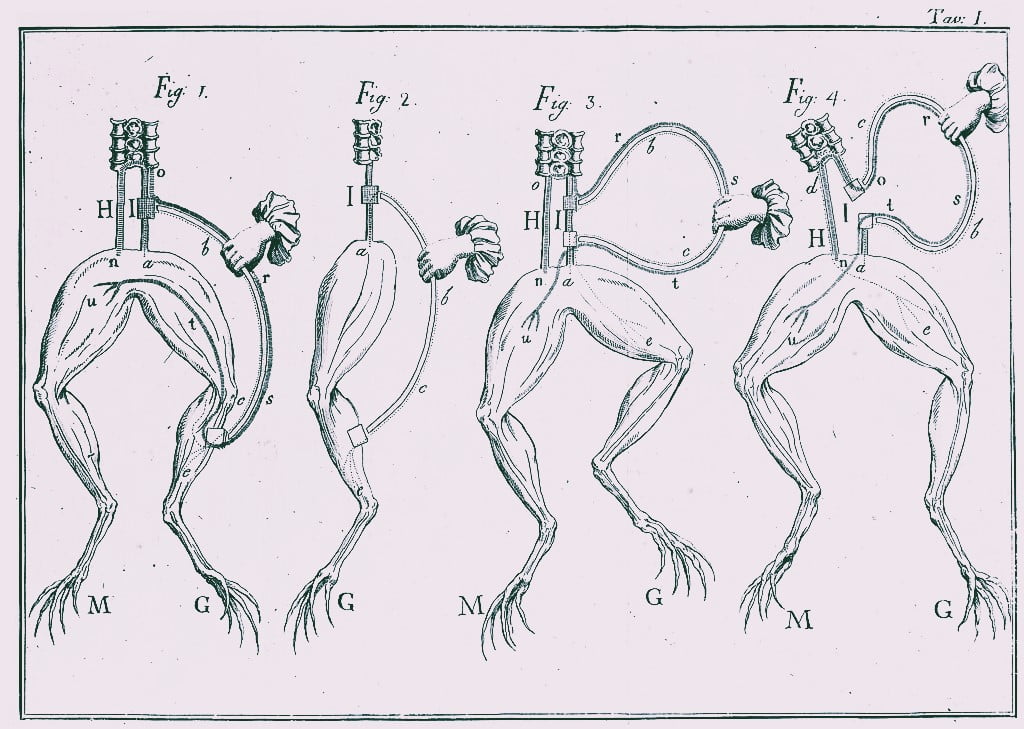
From Spark to Controversy:
- Galvani’s contemporaries, including Alessandro Volta, his former student, offered alternative explanations. Volta argued that the observed contractions arose from the interaction of two dissimilar metals (the scalpel and frog) creating a tiny current, similar to what happened in his voltaic pile (the first battery). This ignited a fierce debate, known as the “Galvani-Volta controversy,” that pushed the boundaries of scientific understanding.
Emil du Bois-Reymond (1818-1896):
While the debate raged, scientists like Emil du Bois-Reymond, a German physiologist, built upon Galvani’s foundation. Using more sophisticated instruments, he demonstrated in 1843 that electrical currents weren’t just present in muscles but also traveled along nerves, triggering muscle contractions. This discovery, the “action potential,” became a cornerstone of neurophysiology, unveiling the electrical language governing communication within our bodies.
Impact and Legacy:
Galvani’s “Bio-Shock” not only ignited the field of bioelectricity but also had profound implications across various disciplines. It paved the way for understanding how electrical signals control muscles, hearts, and even brain function. This knowledge has revolutionized areas like medicine, where electrical stimulation is used for therapies and diagnostics.
Historical References and Studies:
- Galvani, L. (1792). De electricitate musculorum commentarius. Bologna: Ex officina Galeatii.
- Du Bois-Reymond, E. (1843). Untersuchungen über thierische Elektricität. Berlin: G. Reimer.
- Piccolino, M., Bresadola, M. (2013). Luigi Galvani and the frogs’ legs: a tale of a misinterpreted discovery. Journal of Physiology, 591(8), 1939-1942.
- Finger, S. (2000). Origins of Neuroscience: A History of Explorations into Brain Function. Oxford University Press.
Volta’s Power Up (1800):
Alessandro Volta (1745-1827): Igniting the Spark of Continuous Electricity
Born in Como, Italy, Volta initially studied law but soon found himself captivated by the mysteries of electricity. Inspired by Luigi Galvani’s discovery of bioelectricity, Volta embarked on a mission to create a sustained source of electricity, unlike the fleeting sparks observed previously. In 1800, his ingenuity culminated in the voltaic pile, a stack of alternating silver and zinc discs separated by brine-soaked cloth. This invention, arguably the first true battery, revolutionized scientific exploration.
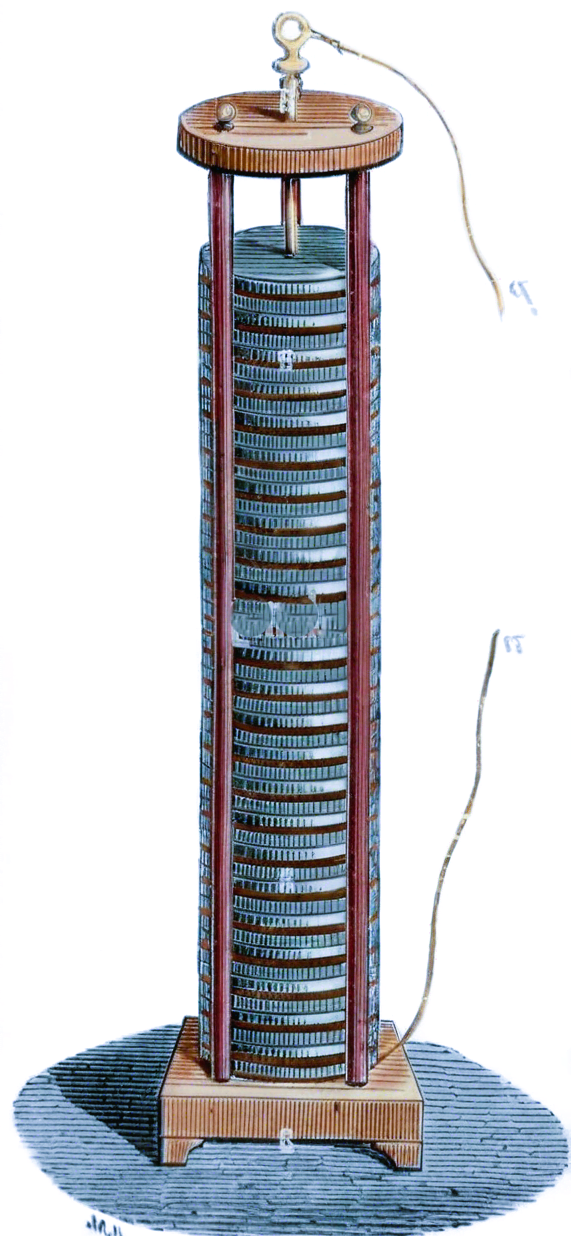
Historical Context:
- Volta’s work came at a time when the scientific community was fiercely debating the nature of electricity. Galvani’s bioelectricity theory, attributing the phenomenon to animal life, clashed with the prevailing belief in “animal electricity.”
- Volta’s voltaic pile provided concrete evidence for non-biological electricity, paving the way for further advancements in electrochemistry and electromagnetism.
Impact:
- The voltaic pile became an essential tool for scientists like Humphry Davy and Michael Faraday, enabling groundbreaking discoveries in electrolysis, chemical analysis, and electromagnetism.
- Volta’s invention laid the foundation for modern batteries, powering everything from portable electronics to electric vehicles.
Volta’s Legacy:
- His name lives on in the unit of electric potential, the volt.
- The voltaic pile remains a symbol of scientific ingenuity and the power of collaboration, building upon the work of others to achieve groundbreaking results.
Humphry Davy (1778-1829): Pushing the Boundaries of Battery Power
Born in Penzance, England, Davy’s fascination with chemistry led him to experiment with Volta’s voltaic pile. He quickly recognized its potential and, driven by a thirst for knowledge, dedicated himself to improving battery technology. In 1807, he achieved a breakthrough with the sodium-potassium battery, using molten salts as electrolytes, which produced a more powerful and efficient current.
Historical Context:
- Davy’s work coincided with the rise of the Industrial Revolution, where reliable and powerful sources of electricity were crucial for technological advancements.
- His sodium-potassium battery found immediate applications in areas like electroplating, metal refining, and medical treatments.
Impact:
- Davy’s battery enabled the isolation of several previously unknown elements, including sodium, potassium, calcium, and magnesium, significantly expanding our understanding of the periodic table.
- His research on electrolysis laid the foundation for electroplating techniques used in various industries today.
Davy’s Legacy:
- He is remembered as a pioneer in electrochemistry and a brilliant chemist who unlocked the secrets of many elements.
- His sodium-potassium battery, though eventually superseded, paved the way for more advanced battery technologies, essential for our modern world.
Electromagnetism Emerges (1819 – 1821):
Hans Christian Ørsted (1777-1851):
- Professor Ørsted, renowned for his meticulous approach, stumbled upon a groundbreaking discovery during a seemingly routine lecture. As he flipped a switch, activating an electric current near a compass needle, the needle inexplicably deflected. This seemingly minor observation, documented in his landmark paper “Experiments on the Effect of a Current of Electricity on the Needle,” shattered the established belief that electricity and magnetism were independent forces. Ørsted had inadvertently flipped the switch on a new era of scientific understanding.
André-Marie Ampère (1775-1836):
- News of Ørsted’s experiment sent shockwaves through the scientific community, particularly reaching the ears of André-Marie Ampère, a French mathematician known for his meticulous calculations and theoretical frameworks. Fueled by Ørsted’s spark, Ampère embarked on a whirlwind of experiments, meticulously charting the interaction between currents and magnets. Within weeks, he had not only confirmed Ørsted’s findings but also formulated his groundbreaking “Ampère’s law,” a mathematical equation that precisely described the force exerted by one current-carrying conductor on another. This equation became a cornerstone of electromagnetism, laying the foundation for future advancements like electric motors and generators.
Joseph Henry (1797-1878):
While Ampère delved into the theoretical depths of electromagnetism in Europe, Joseph Henry, a young American professor, was independently conducting groundbreaking experiments across the Atlantic. Inspired by Ørsted’s work, Henry not only replicated the needle deflection but also extended the discovery, demonstrating that a changing magnetic field could induce an electric current in a nearby conductor – a principle known as electromagnetic induction. This phenomenon formed the basis for transformers, essential components in power transmission and electronics, and ultimately led to the invention of the electric motor.
The stories of these three individuals, their independent yet interconnected journeys, highlight the collaborative nature of scientific progress. Ørsted’s accidental spark ignited a flame of curiosity, Ampère provided the mathematical framework, and Henry’s transatlantic echo demonstrated the universality of the phenomenon. Their combined efforts opened a new frontier, paving the way for groundbreaking technologies that continue to shape our lives today.
Further Exploration:
- “Experiments on the Effect of a Current of Electricity on the Needle” by Hans Christian Ørsted (1819)
- “Ampère’s Law” explained in detail
- The life and work of Joseph Henry
Ohm’s Law and Beyond (1827 – 1861):
Ohm’s Law (1827):
Imagine a world without understanding the relationship between voltage, current, and resistance. Enter Georg Ohm, a German physicist facing skepticism from the scientific community. Through meticulous experimentation with simple circuits and meticulous calculations, he unveiled the now-ubiquitous Ohm’s Law (V = IR) in 1827. This equation, initially met with resistance (pun intended!), became the cornerstone of electrical engineering, allowing for the prediction and control of electrical flow in circuits. Ohm’s Law not only revolutionized circuit design but also laid the foundation for future advancements like power grids and electronic devices.
 |
| Michael Faraday |
Faraday’s Induction: Currents from Magnetism (1831):
Across the English Channel, Michael Faraday, a self-taught scientist with an insatiable curiosity, embarked on a journey that would forever change how we interact with electricity. In 1831, through tireless experimentation with magnets and coils, he discovered electromagnetic induction. Move a magnet near a coil of wire, and voila! Electricity flows! This groundbreaking principle, later refined by Faraday himself, became the bedrock of electric motors, generators, and transformers. Imagine the world without these inventions – no electric cars, no power plants, no buzzing transformers bringing electricity to our homes. Faraday’s discovery unlocked the potential of electricity to not just flow but also be generated and manipulated, paving the way for the electrified world we live in today.
Kirchhoff’s Laws: The Symphony of Complex Circuits (1845):
As electrical systems grew more intricate, the need for a deeper understanding of current flow became paramount. Enter Gustav Kirchhoff, a German physicist who, in 1845, published his Kirchhoff’s circuit laws. These two elegant equations, one governing the conservation of current in a junction (Kirchhoff’s Current Law) and the other governing the conservation of voltage around a closed loop (Kirchhoff’s Voltage Law), provided the tools to analyze and design even the most complex electrical networks. From intricate circuits in modern computers to sprawling power grids, Kirchhoff’s laws ensure the harmonious flow of electricity, preventing short circuits and ensuring efficient operation.
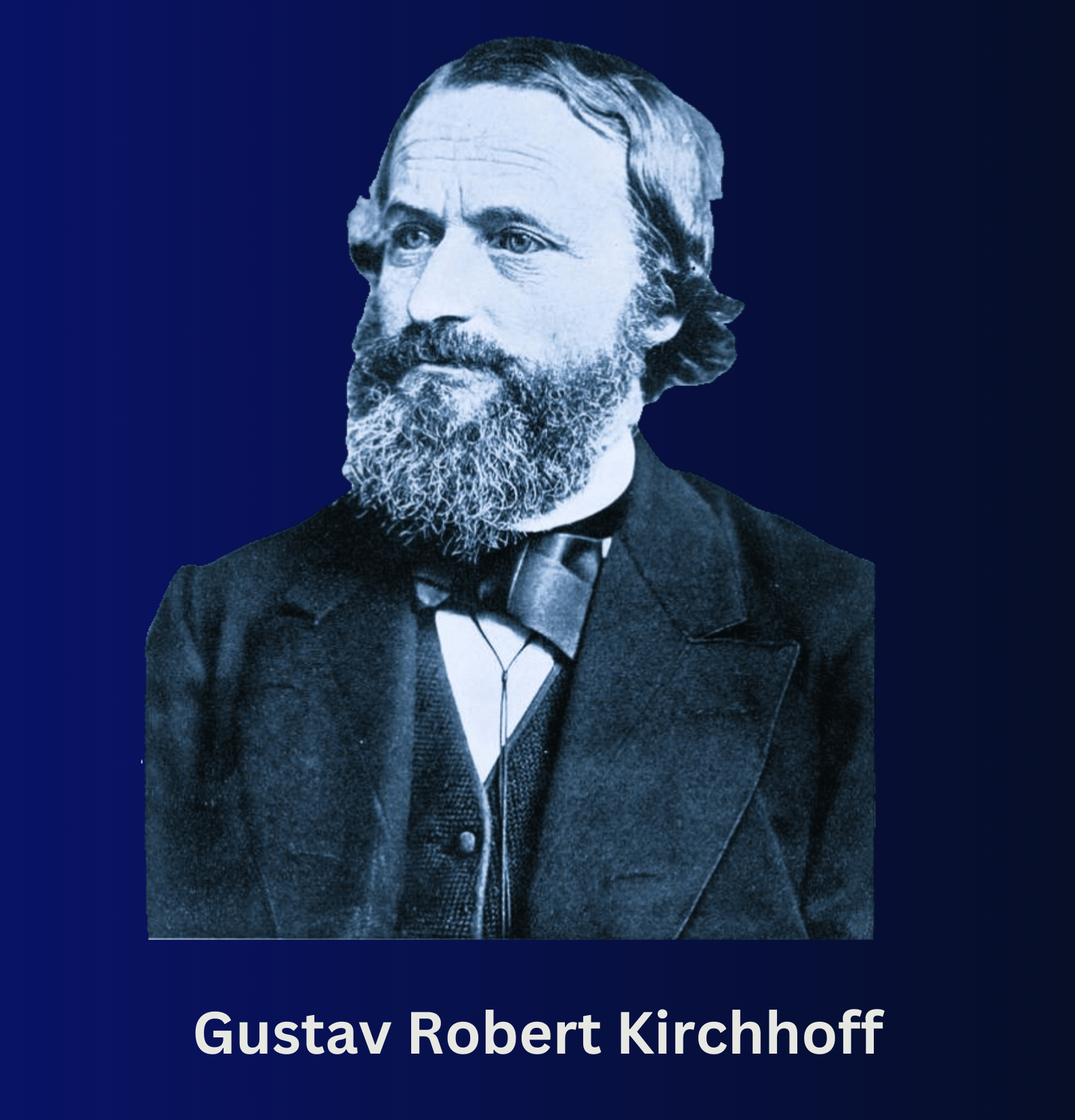
These three giants, each with their unique contributions, painted a vibrant picture of the fundamental principles governing electricity. Ohm’s Law brought order and predictability, Faraday unlocked the potential for generation and manipulation, and Kirchhoff’s laws ensured the smooth flow in complex systems. Their discoveries, born from dedication, curiosity, and a deep understanding of the natural world, continue to illuminate our path forward, powering not just our devices but also our progress as a civilization.
Beyond the Names:
This era wasn’t solely defined by these three individuals. Numerous other scientists, engineers, and inventors played crucial roles. André-Marie Ampère furthered the understanding of electromagnetism, Joseph Henry independently discovered electromagnetic induction alongside Faraday, and Humphry Davy’s work on batteries paved the way for more powerful and efficient energy storage. Each contribution, big or small, fueled the collective understanding and advancement of electrical knowledge.
Historical References and Studies:
- Ohm, Georg Simon (1827). Die galvanische Kette mathematisch bearbeitet. Leopold Voss.
- Faraday, Michael (1832). “Experimental researches in electricity”. Philosophical Transactions of the Royal Society of London.
- Kirchhoff, Gustav Robert (1845). “Über die Vertheilung der Elektricität in einem Leiter mit Berücksichtigung der thermo-elektrischen Kräfte”. Annalen der Physik.
Engineering the Revolution (Late 19th Century):
Hiram Maxim (1840-1916):
- While Thomas Edison often receives the lion’s share of credit for the incandescent light bulb, Hiram Maxim deserves recognition for his crucial contribution. In 1878, Maxim unveiled his own incandescent bulb design, utilizing a thicker carbon filament that boasted a longer lifespan than Edison’s early prototypes. Though ultimately overshadowed by Edison’s commercially successful model, Maxim’s bulb laid the groundwork for practical and enduring electric lighting. His legacy extends beyond illumination, with inventions like the Maxim gun and contributions to aviation solidifying his place as a polymath inventor who helped spark the electrical revolution.
Zénobe Gramme (1826-1901):
- Prior to Gramme’s innovation, large-scale electricity production remained a pipedream. In 1871, he revolutionized the field with the invention of the ring armature, a crucial component in DC generators. This ingenious design allowed for continuous current generation, paving the way for powering homes, factories, and entire cities. Gramme’s invention wasn’t just about technical brilliance; it democratized electricity, ushering in a new era of progress and convenience. His legacy shines brightly in every city illuminated by electric lights, a testament to his transformative contribution.
Historical References and Studies for Further Exploration:
- “The History of Electric Lighting” by Burton Drews: This comprehensive study delves into the early development of incandescent bulbs, including Maxim’s contributions.
- “Gramme’s Ring: The Motor That Drove the Industrial Revolution” by David Bodanis: This engaging book explores the life and work of Zénobe Gramme and the impact of his ring armature invention.
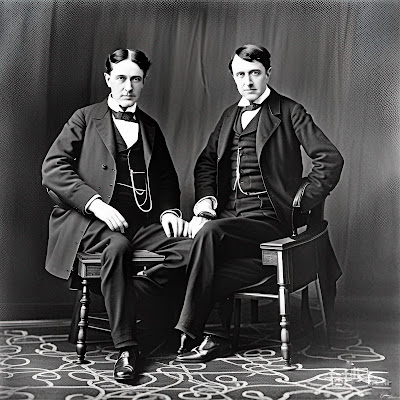 |
| Tesla and Edison |
Power Struggles and AC Triumph (1880s – 1900s):
Thomas Edison (1847-1931):
- Developed a commercially successful incandescent light bulb and DC power systems, sparking the “War of Currents” against AC systems.
Nikola Tesla (1856-1943):
- Championed AC power systems, collaborating with George Westinghouse to build the world’s first AC power plant at Niagara Falls, ultimately winning the “War of Currents.”
Charles Algernon Parsons (1854-1931):
While often overshadowed by the iconic light bulb, Charles Parsons’ steam turbine played a crucial role in powering the electrification revolution. Born in 1854, his engineering brilliance challenged the limitations of reciprocating engines, unveiling a groundbreaking turbine in 1884.
Its impact? Monumental:
- Higher Efficiency: Converting more thermal energy to electricity, it reduced costs and environmental impact.
- Compact & Scalable: Enabling smaller power plants, bringing electricity to previously unreachable areas.
- Continuous Power: Providing smoother and more reliable electricity for sensitive equipment and growing demands.
Parsons’ vision didn’t stop at land. In 1897, Turbinia, the world’s first turbine-powered ship, shattered speed records, revolutionizing naval warfare and ushering in an era of faster, more powerful vessels.
His legacy? Enduring:
- Electrifying the world: By enabling efficient power generation, it brought electricity to homes, factories, and cities.
- Maritime power: Transforming naval warfare and sea travel, it fueled the development of faster, more maneuverable ships.
- Industrial growth: Providing reliable and efficient power, it supported economic development and advancements across various sectors.
Parsons wasn’t just an inventor; he was a visionary. His story reminds us of the power of curiosity, innovation, and perseverance in shaping the world we know today.
Want to delve deeper? Explore “The Steam Turbine and Other Inventions of Sir Charles Parsons” by R H Parsons or visit IMechE’s “Forward Thinkers: Sir Charles Parsons” page.
Quantum Leaps and Solid State (1905 – 1947):
Marie Curie (1867-1934):
- This Polish-French physicist, defying societal norms, delved into the mysterious realm of radioactivity. Her groundbreaking discovery of polonium and radium in 1898 not only unlocked the secrets of atomic disintegration but also paved the way for further atomic research. While not directly linked to electronics, Curie’s work provided crucial insights into the behavior of electrons within atoms, a foundational understanding upon which future electronic advancements would be built.
Albert Einstein (1879-1955):
- This German-born physicist, a beacon of intellectual brilliance, revolutionized our understanding of light and matter with his explanation of the photoelectric effect in 1905. He demonstrated that light wasn’t simply a wave but also behaved like a stream of particles (photons), each carrying a specific amount of energy. This groundbreaking concept formed the cornerstone of quantum mechanics, a branch of physics that would later prove vital in the development of transistors and integrated circuits.
John Bardeen, Walter Houser Brattain, William Shockley (1947):
- At Bell Labs in 1947, this trio etched their names in history by inventing the transistor. This tiny device, no bigger than a fingernail, could amplify or switch electrical signals, replacing bulky and inefficient vacuum tubes. Their revolutionary invention, recognized by the Nobel Prize in 1956, miniaturized electronics, paving the way for smaller, more powerful computers and ushering in the era of microelectronics.
Beyond the Names: Unveiling the Hidden Tapestry
While these individuals stand as giants in the history of electronics, their achievements were built upon the work of countless others. Early pioneers like Heinrich Geitel and Julius Elster explored the photoelectric effect, laying the groundwork for Einstein’s later studies. William Shockley, though a key contributor to the transistor’s development, later faced ethical controversies regarding patent rights, highlighting the complex social and ethical dimensions of scientific progress.
Historical References and Studies:
- “Radioactivity: A History of a Scientific Revolution” by Jean Baptiste Perrin
- “Einstein’s Dice: Quantum Chance and Causal Uncertainty” by Robert Geroch
- “A History of the Transistor” by John Vardalas
- “The Invention of the Transistor” by John Stanley
A Digital Revolution (1950s – Present):
Jack Kilby: Sparking the Microelectronics Revolution (1958):
- Working at Texas Instruments, Kilby, a young engineer just 29, envisioned a device that could house multiple transistors on a single silicon chip. This groundbreaking concept, the integrated circuit (IC), replaced bulky circuits with miniature marvels, paving the way for exponential miniaturization and eventually, computers in our pockets.
- Kilby’s invention wasn’t met with immediate fanfare. Skeptics doubted its feasibility, but his persistence paid off. The IC’s potential resonated with Robert Noyce, another visionary figure who would soon join the digital revolution.
Robert Noyce: From Fairchild to Intel and Beyond (1959):
- Noyce, alongside William Shockley and Gordon Moore, co-founded Fairchild Semiconductor in 1957. While working there, he independently conceived an IC design different from Kilby’s, further solidifying the concept’s importance.
- In 1968, Noyce co-founded Intel, destined to become a global leader in the semiconductor industry. He championed the planar process, a manufacturing technique that revolutionized IC production, making them cheaper and more reliable.
- Noyce’s vision and leadership propelled Intel to the forefront of the digital revolution, powering everything from early computers to the ubiquitous smartphones we hold today.
Beyond the Two Giants: A Symphony of Innovation:
- While Kilby and Noyce stand as prominent figures, their success wasn’t a solo act. Hundreds of engineers, scientists, and entrepreneurs across the globe contributed to the IC revolution.
- Researchers at Bell Labs made crucial advancements in transistor technology, while universities like Stanford and MIT became hubs for groundbreaking research. Companies like Texas Instruments, Motorola, and National Semiconductor joined the fray, fueling fierce competition and rapid innovation.
- This symphony of minds led to advancements like Moore’s Law, which predicted the exponential growth of transistor density on ICs, driving ever-smaller, more powerful devices.
The Impact of the Digital Revolution: Electricity Transformed:
- The consequences of miniaturization were far-reaching. Computers shrank from room-sized behemoths to personal devices, information became readily accessible, and communication evolved from clunky telegrams to instant messaging.
- The internet, powered by miniaturized electronics, emerged, connecting the world like never before. The digital revolution permeated every aspect of life, from healthcare and education to entertainment and finance.
The Journey Continues Electricity’s Unfolding Chapter:
- Today, the digital revolution continues with advancements in artificial intelligence, quantum computing, and the Internet of Things (IoT). Researchers explore new materials like graphene and gallium nitride, pushing the boundaries of miniaturization and efficiency.
- The story of electricity’s transformation from colossal machines to microscopic marvels is a testament to human ingenuity and collaboration. It’s a journey that continues to unfold, shaping our present and propelling us towards an electrifying future.
The Impact of Electricity on Our World:
The advent of practical electric light bulbs, pioneered by inventors like Thomas Edison, ushered in a new era of lighting that went beyond the flicker of gas lamps and candles. This technological breakthrough not only revolutionized indoor and outdoor illumination but also extended work hours, enhancing productivity. Beyond its practical applications, electric lighting fundamentally transformed the way we perceive and interact with our surroundings, ensuring safer and more vibrant cities during the night.
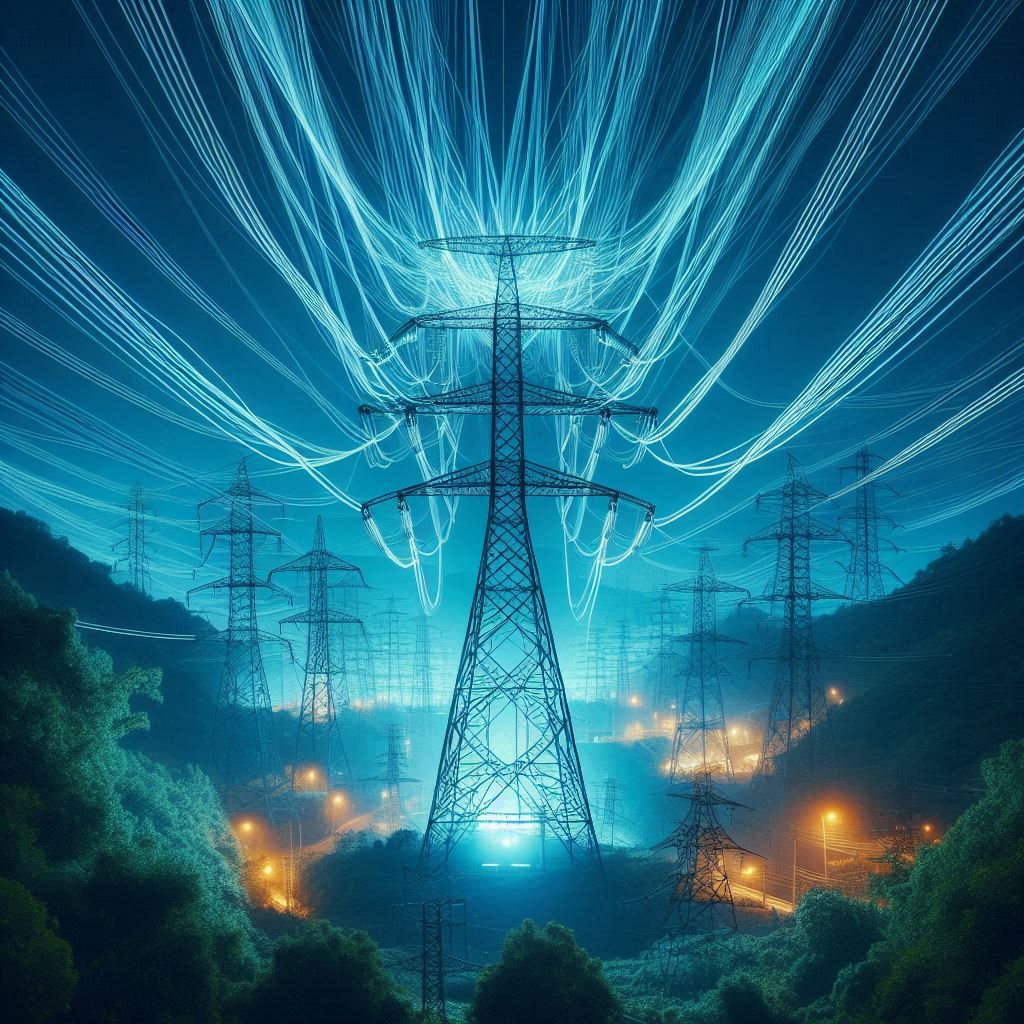
Communication and Information Technology:
The evolution of telegraphy, driven by inventors such as Samuel Morse and advancements in electric communication, laid the groundwork for a global network that transcended geographical boundaries. The telegraph, a marvel of its time, catalyzed the rapid exchange of information over long distances, connecting societies and shaping the trajectory of communication.
As electricity continued to power innovation, the telegraph evolved into a more sophisticated communication system. The invention of the telephone by Alexander Graham Bell and the subsequent development of the internet underscored the profound impact of electricity on communication and information technology. The ability to transmit voice and data with unprecedented speed and efficiency has redefined the way we communicate, bridging gaps and fostering connectivity on a global scale.
Electrification of Industries:
Electricity played a pivotal role in the industrial revolution, transforming manufacturing processes and powering machinery. With the development of electric motors and generators, industries experienced unprecedented levels of efficiency and productivity. Factories powered by electricity became the cornerstone of economic progress, laying the foundation for modern industrialization.
Medical Advancements:
In the field of medicine, electricity has been a catalyst for significant advancements. From the use of electric shock therapy to the development of sophisticated medical imaging technologies, electricity has become an indispensable tool for diagnosis, treatment, and research. Techniques like electrocardiography (ECG) and electroencephalography (EEG) have revolutionized the understanding and monitoring of vital physiological functions.
Transportation Revolution:
Electricity has revolutionized transportation, offering a cleaner and more sustainable alternative to traditional fuel sources. The rise of electric vehicles (EVs) has marked a paradigm shift in the automotive industry, contributing to efforts to reduce carbon emissions and mitigate environmental impact. Electric trains, subways, and trams have transformed urban mobility, providing efficient and eco-friendly transportation options.

The Digital Age:
Entering the digital age, electricity has become the lifeblood of modern technology. From powering data centers that facilitate the internet to fueling the operation of smartphones, computers, and a myriad of electronic devices, electricity is the invisible force driving our interconnected world. The convergence of electricity and digital technologies has given rise to innovations like smart grids, renewable energy integration, and the Internet of Things (IoT), shaping a future where energy efficiency and sustainability are paramount.
Conclusion:
Electricity, from its discovery to its practical applications, undeniably has transformed our lives. Through the efforts of notable scientists and inventors, like Hans Christian Ørsted, Alessandro Volta, Nicola Tesla, and Michael Faraday, electricity has evolved from a mysterious force to a crucial element of our daily lives. Its impact can be seen in various sectors, including lighting, communication, transportation, industry, automation, education, entertainment, healthcare, economic growth and many more. As we continue to harness and innovate with electricity, its influence will undoubtedly shape our future in unimaginable ways.
Also Check relevant blogs:




